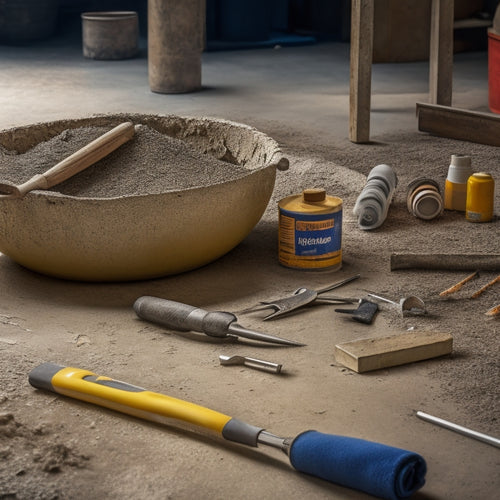
10 Best Tools for DIY Concrete Crack Repair
Share
When tackling a DIY concrete crack repair, you'll need the right tools to guarantee a professional-grade fix. Start with crack detection and assessment tools, like visual inspection and radar testing, to identify crack severity and type. Next, gather epoxy resin injection guns, polyurethane foam injectors, and concrete crack cleaning brushes to prepare the surface. Measure crack width with gauges, and select the right sealant application tools for smooth, even application. Don't forget epoxy and polyurethane mixers, crack filling material dispensers, and protective gear, like gloves, safety goggles, and face masks. With these essential tools, you'll be well-equipped to tackle the repair - and understanding how to use them will make all the difference in achieving a lasting fix.
Key Takeaways
• Accurate crack width measurement is crucial, using tools like calipers, feeler gauges, or optical comparators to guide material and technique selection.
• Epoxy resin injection guns and polyurethane foam injectors provide controlled delivery of repair materials for optimal flow and bonding.
• Concrete crack cleaning brushes, with stiff or soft bristles, remove dirt and debris before repair, ensuring a strong bond between old and new concrete.
• Sealant application tools, such as precision nozzles, ensure smooth and even application of sealants like epoxy, polyurethane, or acrylic.
• Safety gear, including protective gloves, safety goggles, face masks, and respirators, is essential for handling hazardous materials and promoting a safe repair process.
Crack Detection and Assessment Tools
You'll need to identify the cracks in your concrete before you can repair them, which is where crack detection and evaluation tools come in.
These tools help you determine the severity, location, and type of crack, which is vital in selecting the right repair technique. For instance, you may need to identify if the crack is a hairline crack, a structural crack, or a settlement crack.
Crack detection tools can include visual inspection, acoustic emission testing, and radar testing. Once you've identified the crack type, you can move on to evaluating its depth, width, and length.
This information will guide your choice of repair materials and techniques. For example, epoxy-based repair techniques are suitable for structural cracks, while polyurethane-based techniques are better for settlement cracks.
Epoxy Resin Injection Guns
Epoxy resin injection guns are specialized tools designed to accurately deliver epoxy-based repair materials into cracks, providing a precise and controlled flow rate to guarantee a successful and long-lasting repair. When you use an epoxy resin injection gun, you'll appreciate its ability to control the injection pressure, making sure that the epoxy flows smoothly and consistently into the crack. This precise control is essential, as it allows you to achieve the best flow rate for the specific epoxy curing techniques you're using.
You'll also appreciate the gun's ergonomic design, which reduces fatigue and makes it easier to maneuver in tight spaces. The adjustable pressure control feature lets you fine-tune the injection pressure to suit the specific requirements of your repair job. This level of precision guarantees that the epoxy is delivered accurately, without over- or under-injecting the material.
With an epoxy resin injection gun, you can trust that your DIY concrete crack repair will be done safely and effectively, with professional-grade results. By mastering the use of this specialized tool, you'll be able to tackle even the most complex crack repairs with confidence.
Polyurethane Foam Injectors
When tackling DIY concrete crack repairs that require a flexible, water-activated polyurethane foam, a polyurethane foam injector is the ideal tool to guarantee precise control over the injection process. This device allows you to accurately deliver the polyurethane foam into the crack, assuring a successful repair. One of the key polyurethane advantages is its ability to expand and fill the crack, creating a strong and durable bond.
When using a polyurethane foam injector, you'll appreciate the ease of foam application. Simply mix the polyurethane foam with water, and the injector will handle the rest. The injector's precision nozzle ensures a controlled flow of foam, reducing mess and waste. This results in a clean and efficient repair process.
Remember to always follow the manufacturer's instructions and take necessary safety precautions when working with polyurethane foam injectors. Wear protective gear, including gloves and safety glasses, to prevent skin and eye irritation.
With the right tools and a bit of practice, you'll be able to tackle even the most challenging concrete crack repairs with confidence.
Concrete Crack Cleaning Brushes
Cleaning the crack with a concrete crack cleaning brush is an essential step in preparing the surface for repair. This process removes dirt, debris, and old filler material that can compromise the bond between the concrete and the new repair material.
You'll want to choose the right brush type for the job, as there are various options available. Stiff-bristled brushes are ideal for removing heavy debris, while soft-bristled brushes are better suited for cleaning smaller cracks.
When it comes to cleaning techniques, it's vital to work from the bottom of the crack upwards to prevent pushing debris further into the crack. Use gentle, sweeping motions to remove dirt and debris, taking care not to scratch the surrounding concrete.
For particularly stubborn debris, you can use a combination of water and a mild detergent to help loosen it. By using the right brush and cleaning technique, you'll guarantee a clean surface that's ready for repair.
Sealant Application Tools
With the crack thoroughly cleaned, you're now ready to apply a sealant, and the right tools will guarantee a smooth, even application. For this essential step, you'll need a sealant application tool that suits the type of sealant you're using.
There are various sealant types, including epoxy, polyurethane, and acrylic, each requiring specific application techniques. For epoxy-based sealants, you'll need a tool with a precision nozzle to verify accurate application. Polyurethane sealants, on the other hand, require a tool with a larger nozzle to accommodate their thicker consistency. Acrylic sealants are typically applied using a brush or roller, which allows for a more even spread.
When selecting a sealant application tool, consider the size of the crack, the type of sealant, and the surface texture. A tool with adjustable flow control will give you more precision, while a tool with a built-in level will verify the sealant is applied evenly.
Remember to always follow the manufacturer's instructions for the specific sealant type and application technique to achieve a professional-looking result.
Chiseling and Scraping Tools
When you're preparing to repair a concrete crack, you'll need to remove old, damaged concrete and prepare the crack surface.
You'll use chiseling and scraping tools to break away loose material, creating a clean surface for the repair.
Remove Old Concrete
You'll need to break out the heavy-duty tools to remove the old, damaged concrete, starting with a chisel or scraper to dislodge and pry away the deteriorated material. This is a critical step in concrete removal techniques, as it sets the stage for a successful repair.
When selecting a chisel or scraper, consider the size and type of crack you're dealing with, as well as the thickness of the concrete. For smaller cracks, a handheld scraper or chisel may suffice, while larger areas may require a pneumatic or electric chisel.
As you begin to remove the old concrete, be sure to wear proper protective gear, including gloves, safety glasses, and a dust mask. This will help prevent injury from flying debris and dust inhalation.
Use slow, controlled movements to avoid damaging surrounding concrete or underlying structures. Remember to remove all loose material and debris, as this will guarantee a clean surface for the repair.
Prepare Crack Surface
Most cracks require a thorough cleaning and roughening of the surface to guarantee a strong bond between the old and new concrete, which is where chiseling and scraping tools come into play. As you prepare the crack surface, remember that surface preparation is key to a successful repair.
You'll need to remove any dirt, debris, or old concrete residue that may be lodged in the crack. For crack cleaning, use a stiff-bristled brush or a wire brush to sweep away loose particles.
Next, employ a chiseling tool, such as a hammer and chisel or a rotary hammer, to roughen the surface and create a better bonding area. Be cautious not to gouge the surrounding concrete, as this can lead to further damage.
Scraping tools, like putty knives or scraper blades, are also essential for removing old concrete and achieving a smooth surface. Always wear safety goggles and gloves when working with these tools to protect yourself from flying debris and sharp edges.
Crack Width Measurement Gauges
When you're preparing to repair a concrete crack, you'll need to accurately measure its width to determine the best course of action.
You'll classify the crack as hairline, narrow, or wide, and this classification will inform your repair strategy.
To get an accurate measurement, you'll need to choose the right gauge for the job, and that's where understanding the importance of measurement accuracy and gauge selection criteria comes in.
Crack Width Classification
Measure crack widths accurately with crack width measurement gauges, which classify cracks into three categories: hairline (less than 1/16 inch), medium (1/16 to 1/4 inch), and wide (over 1/4 inch).
Accurate classification is vital, as it determines the most suitable repair technique. For instance, hairline cracks often require simple sealing, while medium cracks may need epoxy injection, and wide cracks may demand more extensive repairs, such as concrete replacement.
When evaluating crack widths, it's important to take into account the underlying crack causes. Are the cracks due to settlement, thermal expansion, or poor construction?
Understanding the root cause will help you choose the most effective repair technique. As you inspect the crack, take note of its length, depth, and orientation. This information will aid in selecting the appropriate repair materials and tools.
Measurement Accuracy Matters
You'll get accurate crack width measurements with the right tools, as crack width measurement gauges provide precise readings that classify cracks into their respective categories. To guarantee the accuracy of your measurements, it's important to understand the significance of measurement techniques.
Crack width measurement gauges employ various techniques, including calipers, feeler gauges, and optical comparators, to deliver precise readings. The accuracy of these measurements is critical, as it directly affects the classification and subsequent repair of the crack.
Inaccurate measurements can lead to misclassification, resulting in inadequate repairs that compromise the structural integrity of the concrete. Furthermore, inaccurate measurements can also lead to over- or under-treatment of the crack, wasting resources and time.
Consequently, it's imperative to select a gauge that provides accurate readings and is suitable for the specific type of crack you're dealing with. By using the right gauge and following proper measurement techniques, you can guarantee that your crack width measurements are accurate and reliable, ultimately leading to effective and long-lasting repairs.
Gauge Selection Criteria
With multiple crack width measurement gauges available, selecting the right one for your specific needs requires careful evaluation of several key factors.
You'll want to take into account the type of gauge, as there are digital, mechanical, and feeler gauges, each with its own strengths and limitations. Digital gauges offer high accuracy and ease of use, while mechanical gauges are more affordable and durable. Feeler gauges, on the other hand, are simple and inexpensive, but may require more skill to use accurately.
Another vital factor is gauge calibration. You'll want to verify that your chosen gauge is calibrated to provide accurate readings. Look for gauges that are certified by a reputable organization, such as the National Institute of Standards and Technology (NIST).
Additionally, reflect on the range of measurements the gauge can take, as well as its precision and resolution.
Finally, think about the environment in which you'll be using the gauge. Will you be working in tight spaces or in harsh weather conditions?
Epoxy and Polyurethane Mixers
Mixing epoxy and polyurethane resins correctly is essential to achieving a strong, durable bond, and that's where epoxy and polyurethane mixers come into play. You'll need a mixer that can handle the specific properties of these resins, ensuring a thorough mix that doesn't compromise the epoxy curing processes or polyurethane properties.
When choosing a mixer, consider the following factors:
| Mixer Type | Epoxy Compatibility | Polyurethane Compatibility |
|---|---|---|
| Drill-mounted mixer | Ideal for high-viscosity epoxies | Not recommended for polyurethane |
| Paddle mixer | Suitable for low-viscosity epoxies | Good for polyurethane |
| Vacuum mixer | Best for critical applications | Excellent for polyurethane |
| Hand mixer | Good for small batches | Not ideal for polyurethane |
| Automated mixer | High-volume production | High-volume polyurethane applications |
Protective Gear and Safety Equipment
After properly mixing epoxy and polyurethane resins, it's time to gear up with the necessary protective gear and safety equipment to guarantee your personal safety while handling these chemicals and performing the concrete crack repair process. You don't want to risk exposure to hazardous materials, so make certain you're adequately protected.
First and foremost, you'll need a pair of protective gloves. Look for gloves made from chemical-resistant materials like nitrile or neoprene. These will prevent the epoxy and polyurethane resins from penetrating the skin and causing irritation or worse. You should also opt for gloves with grip patterns on the palms to guarantee you maintain a secure hold on your tools.
Next, don't forget to wear safety goggles. These will shield your eyes from any accidental splashes or spills. Choose goggles with anti-fog coatings to guarantee clear visibility, even in humid environments.
Additionally, consider a face mask or respirator to filter out any airborne particles or fumes. By taking these precautions, you'll be well-equipped to tackle the concrete crack repair process safely and confidently.
Crack Filling Material Dispensers
How do you plan to accurately dispense the epoxy or polyurethane resin into the concrete crack, guaranteeing a precise fill without excess material oozing out?
This is where crack filling material dispensers come into play. These tools are designed to provide a controlled flow of material, allowing you to fill the crack efficiently and effectively.
When selecting a dispenser, consider the type of material you're working with, as different dispensers are designed for specific epoxy or polyurethane resins. Confirm material compatibility to avoid any issues during the repair process.
Look for dispensers with adjustable flow rates and precision nozzles to achieve the perfect fill. Some dispensers also come with built-in mixing tips, which can be beneficial for certain crack filling techniques.
It's crucial to choose a dispenser that suits your specific needs and the size of the crack you're repairing. By using the right dispenser, you'll minimize waste, reduce cleanup, and achieve a professional-looking finish.
Frequently Asked Questions
How Long Does It Take for Epoxy Resin to Fully Cure?
When working with epoxy resin, you'll want to know how long it takes to fully cure.
The epoxy curing process depends on the resin type and environmental factors. Generally, most epoxies take 24 hours to reach initial set, but full cure can take 3-7 days. Some slow-cure epoxies can take up to 14 days.
Make sure to follow the manufacturer's instructions and wait for the recommended time before handling or exposing the repaired area to stress or heavy use.
Can I Use Polyurethane Foam for Hairline Cracks?
You're considering using polyurethane foam for hairline cracks, but you should exercise caution.
While polyurethane foam has various applications, it's not the ideal solution for hairline crack repairs.
Foam expands, which can exacerbate the crack, and its adhesive properties can be compromised by moisture.
Instead, look for hairline crack solutions specifically designed for concrete repair, ensuring a safe and durable fix.
Do I Need to Prime the Crack Before Applying Sealant?
Before applying sealant, you'll need to prime the crack to guarantee proper adhesion.
This vital step in crack preparation is often overlooked, but it's essential for a strong bond. Failing to prime can lead to sealant failure, putting your structure's integrity at risk.
You'll want to clean the crack thoroughly, removing any dirt or debris, and then apply a primer specifically designed for concrete.
This will create a strong bond between the crack and sealant, securing a safe and long-lasting repair.
Are Concrete Crack Repair Tools Suitable for Epoxy-Coated Floors?
When working with epoxy-coated floors, you'll need to guarantee the concrete crack repair tools you're using are compatible.
Before applying epoxy, you'll need to properly prepare the surface, which may require specialized tools.
You'll want to select tools designed for epoxy application, as they'll help you achieve a strong bond.
Proper surface preparation is vital to prevent the epoxy from peeling or delaminating, making certain a safe and durable repair.
Can I Repair Cracks in Frozen or Wet Concrete?
Imagine trying to fix a crack in a frozen lake - it's a futile effort.
Similarly, repairing cracks in frozen concrete is a losing battle.
The same applies to wet conditions, where water seeps into the crack, making it impossible to create a strong bond.
Don't risk your safety by attempting to repair cracks in these conditions.
Wait for the concrete to thaw or dry completely before starting the repair process.
Conclusion
You've got the right stuff to tackle that DIY concrete crack repair like a pro!
With these 10 must-have tools in your arsenal, you'll be filling cracks like a modern-day Renaissance master, minus the frescoes and ornate fonts.
Remember, a solid repair is just a well-executed plan away.
So, gear up, get to work, and don't let those cracks get the best of you - or your concrete!
Related Posts
-

Top Tools for Repairing Cracked Concrete Surfaces
When tackling a cracked concrete surface repair, you'll need the right tools to guarantee a durable fix. Start with e...
-

Top Tools for Mixing Concrete at Home
When mixing concrete at home, you'll need a range of tools to guarantee a successful operation. Start with essential ...
-

10 Must-Have Tools for Small Concrete Projects
When tackling small concrete projects, you'll need a range of essential tools to achieve professional-grade results. ...


